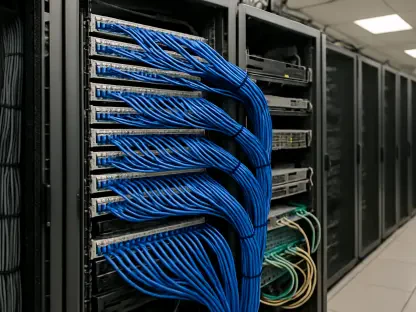Texas is witnessing a technological transformation, positioning itself as a prominent hub for AI data centers. Housing Tesla’s 50,000-GPU supercomputer, Cortex, the state is set to welcome OpenAI’s ambitious Stargate project, initiating a $100 billion investment into AI infrastructure. As hyperscalers capitalize on Texas’s expansive space and robust power capacity, colossal volumes of data will transit through these centers at unprecedented speeds.
The Connectivity Divide
Challenges in Rural Texas
However, this technological advancement starkly contrasts with the connectivity struggles faced by many Texans, particularly in rural areas. According to the most recent US census data, 7 million Texans lack broadband access, limiting their ability to receive essential services from government agencies. This digital divide is a significant barrier, affecting the livelihoods and opportunities of residents in these areas. The disparity in access is evident in the inability of approximately 23% of Texans to attend online classes, access healthcare providers virtually, apply for jobs online, start businesses, or engage with online marketplaces. These gaps not only affect individual quality of life but also constrict broader economic opportunities within the state.
Impact on Quality of Life
The ramifications of limited connectivity extend beyond basic internet access. Texas Comptroller Glenn Hegar emphasized the broader societal impact, highlighting that the lack of internet access prevents many from engaging in crucial day-to-day activities such as remote education, telehealth services, and digital commerce. This digital shortfall significantly diminishes their quality of life and curtails the state’s potential for economic growth. The inability to connect to the digital world leaves many Texans isolated from educational resources, healthcare services, and economic opportunities. These barriers impede social mobility and widen the gap between urban and rural communities, presenting a formidable challenge for the state’s growth and development.
Duos Edge AI: A Potential Solution
Introduction of Duos Edge AI
The connectivity crisis has permeated school classrooms across rural Texas, depriving pupils of vital resources available to their peers in more connected regions. Enter Duos Edge AI, a pioneering company striving to bridge this digital divide through a network of Edge data centers. The company, a subsidiary of Duos Technologies based in Jacksonville, Florida, leverages its extensive experience in machine vision-based solutions to tackle the connectivity issue. By deploying Edge data centers adjacent to railways in partnership with Amtrak, they have found a way to extend this technology for third-party applications, thereby enhancing connectivity in underserved regions.
Leveraging Existing Expertise
Duos Edge AI has historically focused on automating inspections of trains and trucks through machine vision-based solutions. Their system involves trains passing through inspection portals equipped with numerous cameras, capturing images of each wagon to conduct remote inspections and flag mechanical issues. This experience has positioned them uniquely to deploy Edge data centers across varied environments. When they identified an opportunity to expand into the Edge computing business, Duos Technologies sought out Doug Recker, a seasoned veteran in the data center industry, to lead this venture. Recker’s background and expertise in the field have been instrumental in navigating the complexities of this expansion.
Strategic Collaboration
Leveraging their expertise in deploying Edge data centers along railways, Duos Technologies identified a new avenue to address the rural connectivity crisis. Recognizing the need for experienced leadership, they collaborated with Doug Recker, whose extensive background in data center development provided a foundation for this ambitious project. Recker, known for building and selling two successful data center businesses, has brought invaluable insight to the initiative. His prior ventures, Colo5 and EdgePresence, demonstrated his ability to innovate and scale data center operations successfully, making him an ideal partner for this initiative.
Doug Recker’s Vision
Track Record of Success
Doug Recker’s professional journey is marked by success in the data center industry. He founded Colo5 in 2008, developing two large-scale data centers in Jacksonville and Lakeland, Florida, which were sold to Cologix in 2014. Recker re-emerged in 2017 as the CEO of EdgePresence, where he rolled out 100kW Edge data centers housed in containers across the United States. His strategy included supporting telecom infrastructure firms and securing significant investments, culminating in acquisitions that underscored his ability to drive impactful results in the tech sector.
Philanthropic Inspiration
Recker’s experience extends beyond the commercial realm. His international work with an NGO, Matter, in Zimbabwe, profoundly influenced his current endeavor. There, he deployed Innovation Hub Pods — air-conditioned classrooms equipped with solar-powered connectivity — enabling children to master computer skills quickly. This experience galvanized his mission to provide similar opportunities in the United States. Witnessing how rapidly the children could adapt to and benefit from these technological resources, Recker was inspired to address similar disparities in rural American schools, which face unique connectivity challenges that disadvantage pupils compared to their urban counterparts. The Covid-19 pandemic further highlighted these inequalities, with unreliable broadband connections and distant servers exacerbating the problem.
Implementing Edge Data Centers
Addressing Rural School Challenges
Rural American schools, grappling with unique connectivity challenges, often find their pupils at a distinct disadvantage compared to their urban peers. The Covid-19 pandemic underscored these disparities, as online education became challenging due to unreliable broadband connections and overloaded school district servers located hundreds of miles away. Duos Edge AI aims to resolve these issues by deploying Edge data centers across school districts. These centers, containing 15 cabinets within structures approximately 55ft by 13ft, are designed to be installed on municipal land and connect directly to local schools. This configuration offers significantly faster and more reliable access to online services, ensuring that rural students receive the educational resources they need.
Technical Specifications and Benefits
Launched in June 2024, Duos Edge AI’s pods are engineered to support low-density applications like educational platforms, averaging 5-6kW per cabinet. While capable of supporting up to 300kW across 15 cabinets with a cooling system upgrade, the current applications do not require such high power levels. These pods are strategically placed at key locations to ensure sufficient power availability without straining local resources. Their placement in education hubs — often repurposed grocery stores or warehouses — allows them to house critical administrative functions and benefit from existing infrastructure. This approach enhances the digital infrastructure of rural areas, making it easier for students to access the resources they need for their education.
Initial Success in Amarillo
Improved Connectivity
The inaugural project in Amarillo, Texas, has demonstrated the potential of Duos Edge AI’s innovative approach. By partnering with FiberLight to build fiber connections, the company successfully reduced the maximum distance from the hub for schools to just 9 miles. This significant improvement in connectivity resilience has enhanced the competitiveness of schools in the area, making it easier for students to participate in online learning. The project’s success underscores the viability of deploying Edge data centers to address rural connectivity issues, bringing about a much-needed change in the digital landscape of these communities.
Versatility in Applications
Duos Edge AI’s cabinets are designed for versatility, catering to a range of low-density applications such as educational platforms. Each cabinet averages 5-6kW, yet the entire setup can support up to 300kW with appropriate cooling system upgrades. However, current applications in educational environments do not necessitate such high power levels, making the existing setup more than adequate. The pods’ strategic placement in locations like education sector hubs ensures that power resources are well managed without overburdening local utilities. This thoughtful deployment not only bolsters digital connectivity but also ensures that the infrastructure is sustainable and efficient.
Community Impact
Enhanced Local Infrastructure
The launch in Amarillo has received positive feedback from various sectors, extending beyond education to include local clinics, hospitals, city government, police and fire services, and universities. These entities have benefited from the improved digital infrastructure, which mimics the capabilities of a major data center at a fraction of the cost. This widespread acceptance highlights the broader utility of the Edge data centers, which can enhance digital infrastructure across multiple community services. As a result, the community as a whole sees significant improvements in service delivery and connectivity.
Promoting Digital Equity
Michael Keough, Region 16’s CTO, emphasized the critical role of Edge data centers in promoting digital equity within rural communities. These centers enable more equitable access to educational resources, healthcare services, and economic opportunities, thus leveling the playing field for rural residents. This enhanced access helps to bridge the digital divide, ensuring that rural communities are not left behind as technology continues to advance. The implementation of these Edge data centers is fundamental to fostering competitive parity within Texas and across the nation, promoting inclusion and equitable growth.
Future Prospects
Expansion Plans
Duos Edge AI has ambitious plans to extend its reach to more school districts in Texas and beyond, eyeing underserved rural markets for further expansion. Doug Recker anticipates significant growth in agricultural applications as farmers increasingly rely on drones and AI systems to monitor livestock and crops. These technologies generate substantial data that require efficient computation — a need that Duos Edge AI’s pods are well-equipped to fulfill. By facilitating better connectivity and data processing capabilities, these pods can revolutionize farming practices, making agriculture more efficient and productive.
Synergistic Implementation
Texas is undergoing an impressive technological transformation, positioning itself as a key center for AI data centers. Tesla has already established its 50,000-GPU supercomputer, Cortex, in the state. Texas is now gearing up to host OpenAI’s ambitious Stargate project, which is set to drive a massive $100 billion investment into AI infrastructure.
The state’s vast open spaces and strong power capacity make it an ideal location for hyperscalers. These entities will take advantage of Texas’s potential, enabling enormous volumes of data to travel through these centers at previously unimaginable speeds.
This technological boom is not just about the hardware and data throughput. It also signifies a substantial economic opportunity for Texas, creating jobs and fostering innovation. Companies specializing in artificial intelligence and data processing will likely flock to the state, drawn by the robust infrastructure and supportive environment.
In addition, the rise of AI data centers in Texas reflects a broader trend towards decentralizing tech hubs, traditionally concentrated in places like Silicon Valley. This shift could balance economic growth across different regions, reducing congestion and cost-of-living pressures in overburdened areas. As Texas embraces this technological revolution, it stands poised to become a crucial player in the future of AI and data processing.









